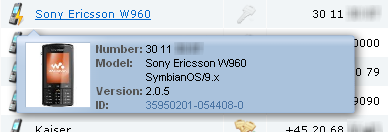This column shows the date and time of the current server.log entry.
This column shows the name of the server or connector for which the information was logged. This information is needed in load balanced or distributed environments and in fail-over situations in order to be able to pinpoint the server machine which issued the message or warning. The name is defined in the field Server name. For more information, see Web - a section of the Server configuration panel.
This column shows the device to which the log message pertains. If you let the mouse pointer rest on a device link, a box will appear with more information about the current device:
- Device phone number
- Device model
- Device operating system
- DME version installed on device
- Device ID
- Possibly a picture of the device

The information derives from the DME database, and can be edited in the Device setup panel. You can click the device link to go to the setup page for the device in question.
If the message does not concern a specific device, but is a system error message or warning, this column contains a dash -.
This column shows the user who is the current holder of the device to which the log message pertains. If you let the mouse pointer rest on a user link, a box will appear with more information about the current user:
- Full name and initials of device user
- Title of device user
The information derives from the DME database, that is the information which can be edited in the User setup panel. You can click the user link to go to the setup page for the user in question.
The messages shown in the log are divided into a number of categories, each of which is described in the following section.
The message column contains the message itself. For more information about the messages that can be displayed here, see the various subsections of the Category section previously.
If the log entry reports a WARNING or an ERROR, you can expand the log to see the full error message by clicking the + button in the right side of the Message column header. The error message may report important information about faulty configuration of a subsystem, such as the LDAP or collaboration system ("user not found" or similar), or it may report an error in DME (usually in the form of an NPE - NullPointerException). Collapse the log again by clicking the - button.